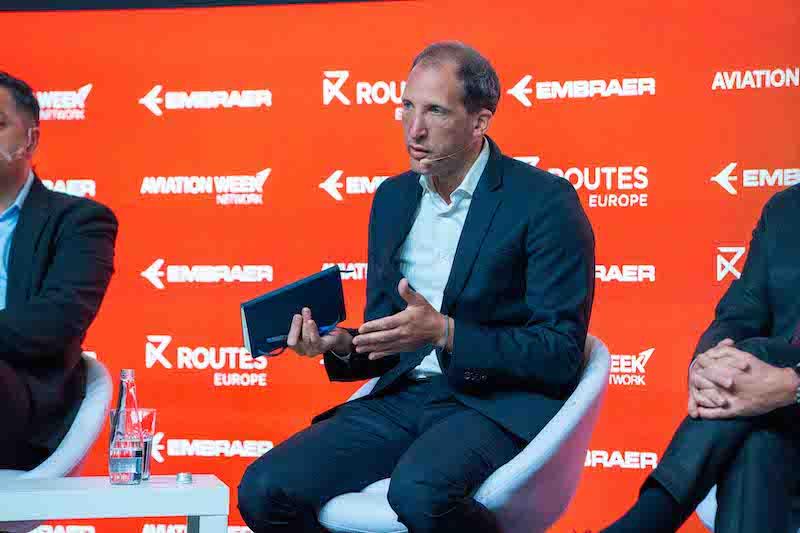
TAP Air Portugal's Henri-Charles Ozarovsky.
TAP Air Portugal carried 7.6 million passengers during the first half of 2023, reaching 96% of the figure achieved in 2019. Henri-Charles Ozarovsky, head of strategy, network and partnerships, speaks to Routes Daily about the current and future demand picture and why the airline is an attractive takeover proposition.
How has TAP’s capacity and network recovered, compared with pre-pandemic levels?
We are actually quite close to 2019 levels. If you look at selected markets, some are performing even better, such as Brazil and the US. To make a comparison, if you consider the markets we used to serve in 2019 and what we operate today, eliminating some unprofitable routes, we have become more efficient. We achieve slightly higher aircraft utilization, have created better schedules, and offer an attractive product to customers with various options in terms of frequency and timing. Many markets similar to ours, like Greece and Morocco, have also recovered well. However, the distinctive factor for us compared to others is the unique appeal of Portugal. Portugal offers a wide range of attractions, from its rich history and culture to outdoor activities like sailing and surfing, as well as fantastic museums and cuisine. Visitors can enjoy both city life and nature, and we offer a stopover program that allows travelers to combine a visit to Portugal with another destination, providing flexibility and control over their travel plans. Personalization is crucial in today's travel industry, and we believe this gives us a competitive advantage.
How would you evaluate TAP's performance during the summer 2023 season?
The summer season has been good for us, as it has been for many airlines. We are pleased with the bookings and demand, and we made plans accordingly to meet this demand. Thankfully, we made the right informed decisions, even though they involved some risks. Like many airlines, we faced challenges such as delivery delays, engine issues, ATC challenges, airport constraints, and labor shortages. However, our increased organizational agility has helped us fare better than others, and we are committed to delivering the best possible experience to our customers.
What levels of demand do you anticipate for this winter and how is this affecting your network planning?
We announced our winter schedule several months ago, and we are proceeding cautiously. While Portugal remains a popular tourist destination, we are mindful of uncertainties surrounding disposable income and inflation. To mitigate risk, we are expanding partnerships, like our recent agreement with SAS Scandinavian Airlines, and closely monitoring the competitive landscape. We aim to focus on our core markets and deliver the best product to customers in those areas where we have a strong market presence, allowing us to capture demand effectively.
What are your network plans for summer 2024? Are you focusing on the markets that were strong in 2023 or can we expect any new destinations?
Like all airlines, we continue to evaluate new destinations, and we always have an updated shortlist. However, we continue to focus on our core and reinforce this network depth and breadth. It's working very well because we've strengthened our Brazil-Europe flows, we've boosted North America to Southern Europe flows, and we've also improved our Africa to Europe flows. And that creates the baseline for further growth. There's still a lot of movement in the markets and still a lot of capacity coming back. So, we're waiting for that noise to die out before we consider other markets. And I think that's justified. It doesn't mean that we can't change—we're nimble—but we need to have consistency.
The long-awaited privatization process of TAP is underway and has already attracted interest from several airline groups. What makes TAP such an attractive takeover proposition from a network perspective?
TAP had to relinquish slots at its Lisbon Airport hub as a competition remedy. How have you responded to the added competition, particularly from easyJet and from Ryanair?
We took it as an opportunity to improve ourselves and to ensure that if we are to compete effectively, we should offer the best customer service and operational reliability. We asked ourselves a fundamental question: “Are we comfortable that what we are flying is right?” Following this, we went through a whole detailed analysis. We’ve also worked extremely hard to boost the operational resilience. What's interesting is, although there's more competition, the market always finds a way to rebalance itself. And competition is good for the consumer. So we support great choice.
What is it that you want to hear from potential or existing airport partners at Routes World?
If you're in a constrained environment, you have a duty to make sure that every single slot you're using generates the highest return on investment. We leverage data from the airports to ensure that we are capturing all the right demand and ensuring that at any point in time, we have the ability to be flexible if something doesn't work out. Our message is very clear: We're absolutely interested in all the information airports give us. We're very grateful. We use it for competitive landscapes; we use it for opportunities. And if we can, we will find a way to make it happen. But we're not the biggest airline in the world. We don't have unlimited slots, unlimited funds, so we have to make informed decisions.
